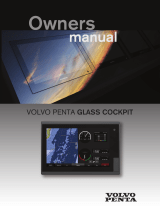
Before you can mount the antenna on a wooden, metal, or
plastic surface using the double-sided seal pad, you must make
sure the surface is clean and free of grease or debris.
Before you mount the antenna, you must test the mounting
location for correct operation (Testing the Mounting Location,
page 2).
You can either mount the antenna on a flat surface using the
threaded rods and thumbscrews and the included single-sided
seal pad, or you can adhere the antenna to a wooden, metal, or
plastic surface using the double-sided seal pad only.
You can route the antenna cable either through the mounting
surface or on top of the mounting surface.
1
Use a 2.5 mm hex wrench to remove the pole mount adapter
from the antenna.
2
If you are mounting the antenna with the threaded rods and
thumbscrews, use a 1.5 mm hex wrench to install the
threaded rods
À
into the bottom of the antenna.
3
Determine the direction the antenna must face on the
surface.
NOTE: If you plan to route the cable through the side of the
antenna, you must consider the direction of the opening
Á
when determining the mounting position.
4
If you are mounting the antenna with the threaded rods and
thumbscrews, use the single-sided seal pad
Â
as a template
to mark the pilot holes
Ã
on the mounting surface.
NOTE: Do not adhere the seal pad to the mounting surface
or the antenna until directed.
5
If you are routing the cable through the mounting surface,
mark the center hole
Ä
of the seal pad.
6
Use a 4 mm bit to drill the pilot holes in the mounting surface.
7
If you are routing the cable through the mounting surface,
use a 15 mm bit to drill the center hole.
8
Select an option:
• If you are mounting the antenna with the threaded rods
and thumbscrews, remove the paper backing from the
single-sided seal pad.
• If you are mounting the antenna on the surface with the
double-sided seal pad, remove the paper backing from
one side of the double-sided seal pad.
9
Select an option:
• If you are routing the cable through the mounting surface,
insert it through the seal pad, feed it through the hole you
drilled in step 7, and adhere the seal pad to the bottom of
the antenna.
• If you are routing the cable through the side of the
antenna, insert it through the opening in the side and
adhere the seal pad to the bottom of the antenna.
10
Select an option:
• If you are mounting the antenna with the threaded rods
and thumbscrews, proceed to step 11.
• If you are mounting the antenna with the double-sided
seal pad, remove the paper backing from the other side of
the seal pad, press it firmly to adhere it to the mounting
surface, and proceed to step 13.
11
Place the antenna on the mounting surface, inserting the
threaded rods through the holes you drilled in step 6.
12
Install the included thumbscrews
Å
on the threaded rods on
the other side of the mounting surface to secure the antenna.
13
Fill the opening on the side of the antenna with marine
sealant (optional).
14
Route the cable away from sources of electronic interference.
Tuning DAB Stations
Before you can tune in to DAB stations, you must update your
compatible FUSION device with the latest software (Software
Updates, page 4).
DAB stations are organized by ensembles, or collections. After
you select an ensemble, you can tune in to a station in that
ensemble.
NOTE: These instructions are general guidelines for tuning DAB
stations on a compatible FUSION device.
1
Turn on the FUSION device.
2
In the settings menu, select your local tuner region.
DAB broadcasts are not available in all regions. When the
stereo is not set to a compatible region, the DAB source is
not available.
3
Select the DAB source.
4
Search for and select an ensemble.
5
Select a station in the ensemble.
Specifications
DAB Module
Specification Value
DAB standard compatibility DAB and DAB+
DAB frequency band Band III (174 to 240 MHz)
DAB transmission modes Mode I
Sensitivity -97 dBm
Input voltage From 10.8 to 16 Vdc
Input current 250 mA
Output voltage to antenna From 8 to 15 Vdc
Output current to antenna 50 mA maximum
Antenna connector type FAKRA Z-type waterblue male
Compatible with SMB connectors
Power/control/audio stereo
connector
10-pin mini DIN
Dimensions (H × W × D) 58 × 64 × 21 mm (2.28 × 2.52 ×
0.83 in.)
Power/control/audio stereo cable
length
1.5 m (4.9 ft.)
Weight 103 g (3.63 oz.)
Water rating IEC 60529 IPX3 (Withstands
exposure to dripping water when
installed with the connectors
pointing downward.)
Operating temperature range From 0 to 50°C (from 32 to 122°F)
MS-DAB100A Installation Instructions 3




